Leadership and Continuous Improvement: An Analysis of M&S Strategies
VerifiedAdded on 2020/10/23
|13
|3818
|97
Report
AI Summary
This report delves into the critical aspects of continuous organizational improvement, using Marks & Spencer (M&S) as a case study. It begins by defining organizational culture and its impact on continuous improvement, highlighting innovative, aggressive, outcome-oriented, and people-oriented cultures. The report then analyzes approaches to facilitate change introduction and acceptance, including education and communication, participation, negotiation, and facilitation. It further evaluates continuous quality improvement approaches, with a focus on the Six Sigma methodology and its benefits. The report examines leadership styles (transactional and transformational) that foster continuous improvement and assesses the importance of continuous improvement in supporting organizational success, such as employee engagement and reduced turnover. It explores sources of information used to identify improvement needs, including meetings, interviews, and surveys. The role of Big Data in enhancing customer engagement, operational efficiency, order fulfillment, and supplier management is also analyzed. The report concludes with a comprehensive overview of the strategies and their impact on organizational performance.
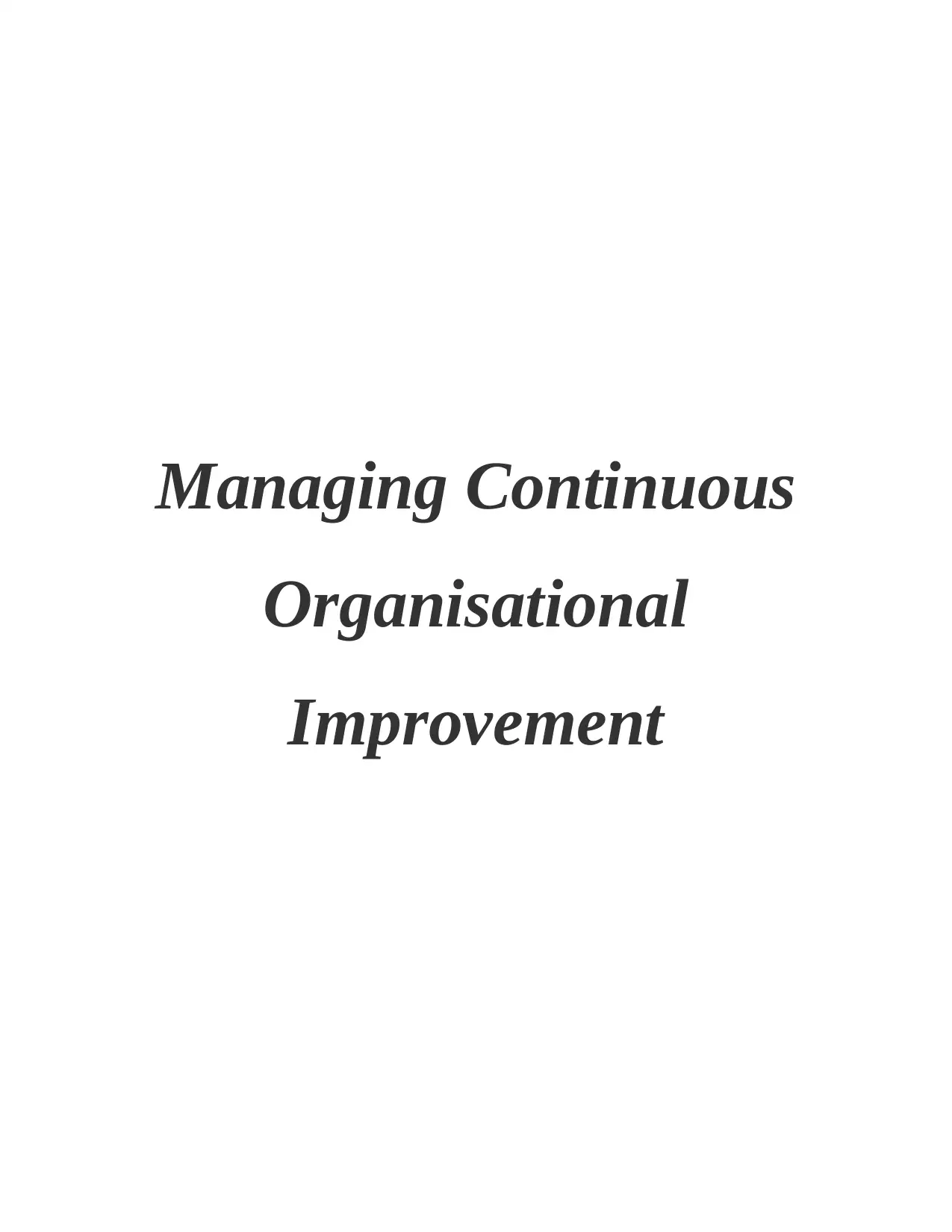
Managing Continuous
Organisational
Improvement
Organisational
Improvement
Paraphrase This Document
Need a fresh take? Get an instant paraphrase of this document with our AI Paraphraser
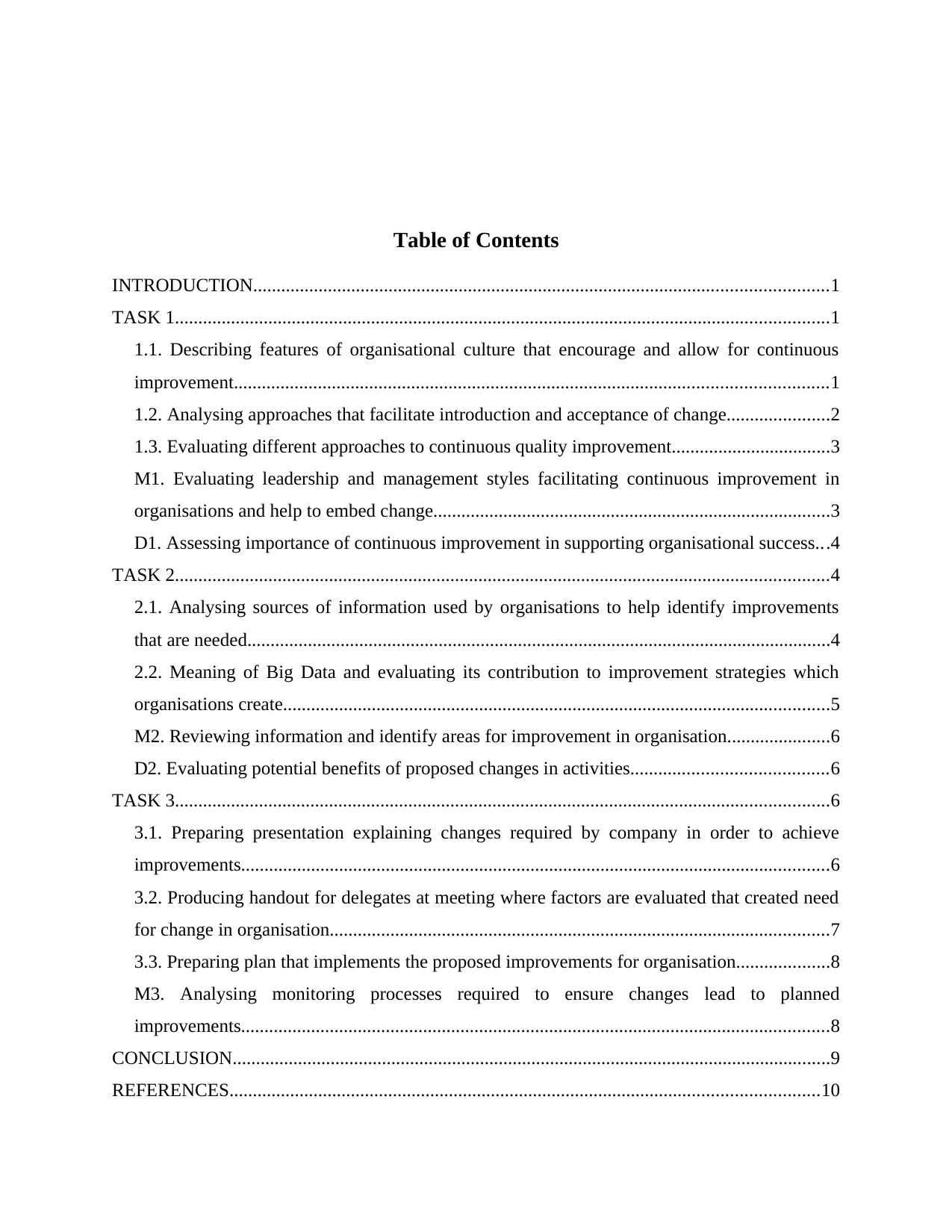
Table of Contents
INTRODUCTION...........................................................................................................................1
TASK 1............................................................................................................................................1
1.1. Describing features of organisational culture that encourage and allow for continuous
improvement...............................................................................................................................1
1.2. Analysing approaches that facilitate introduction and acceptance of change......................2
1.3. Evaluating different approaches to continuous quality improvement..................................3
M1. Evaluating leadership and management styles facilitating continuous improvement in
organisations and help to embed change.....................................................................................3
D1. Assessing importance of continuous improvement in supporting organisational success...4
TASK 2............................................................................................................................................4
2.1. Analysing sources of information used by organisations to help identify improvements
that are needed.............................................................................................................................4
2.2. Meaning of Big Data and evaluating its contribution to improvement strategies which
organisations create.....................................................................................................................5
M2. Reviewing information and identify areas for improvement in organisation......................6
D2. Evaluating potential benefits of proposed changes in activities..........................................6
TASK 3............................................................................................................................................6
3.1. Preparing presentation explaining changes required by company in order to achieve
improvements..............................................................................................................................6
3.2. Producing handout for delegates at meeting where factors are evaluated that created need
for change in organisation...........................................................................................................7
3.3. Preparing plan that implements the proposed improvements for organisation....................8
M3. Analysing monitoring processes required to ensure changes lead to planned
improvements..............................................................................................................................8
CONCLUSION................................................................................................................................9
REFERENCES..............................................................................................................................10
INTRODUCTION...........................................................................................................................1
TASK 1............................................................................................................................................1
1.1. Describing features of organisational culture that encourage and allow for continuous
improvement...............................................................................................................................1
1.2. Analysing approaches that facilitate introduction and acceptance of change......................2
1.3. Evaluating different approaches to continuous quality improvement..................................3
M1. Evaluating leadership and management styles facilitating continuous improvement in
organisations and help to embed change.....................................................................................3
D1. Assessing importance of continuous improvement in supporting organisational success...4
TASK 2............................................................................................................................................4
2.1. Analysing sources of information used by organisations to help identify improvements
that are needed.............................................................................................................................4
2.2. Meaning of Big Data and evaluating its contribution to improvement strategies which
organisations create.....................................................................................................................5
M2. Reviewing information and identify areas for improvement in organisation......................6
D2. Evaluating potential benefits of proposed changes in activities..........................................6
TASK 3............................................................................................................................................6
3.1. Preparing presentation explaining changes required by company in order to achieve
improvements..............................................................................................................................6
3.2. Producing handout for delegates at meeting where factors are evaluated that created need
for change in organisation...........................................................................................................7
3.3. Preparing plan that implements the proposed improvements for organisation....................8
M3. Analysing monitoring processes required to ensure changes lead to planned
improvements..............................................................................................................................8
CONCLUSION................................................................................................................................9
REFERENCES..............................................................................................................................10

⊘ This is a preview!⊘
Do you want full access?
Subscribe today to unlock all pages.

Trusted by 1+ million students worldwide
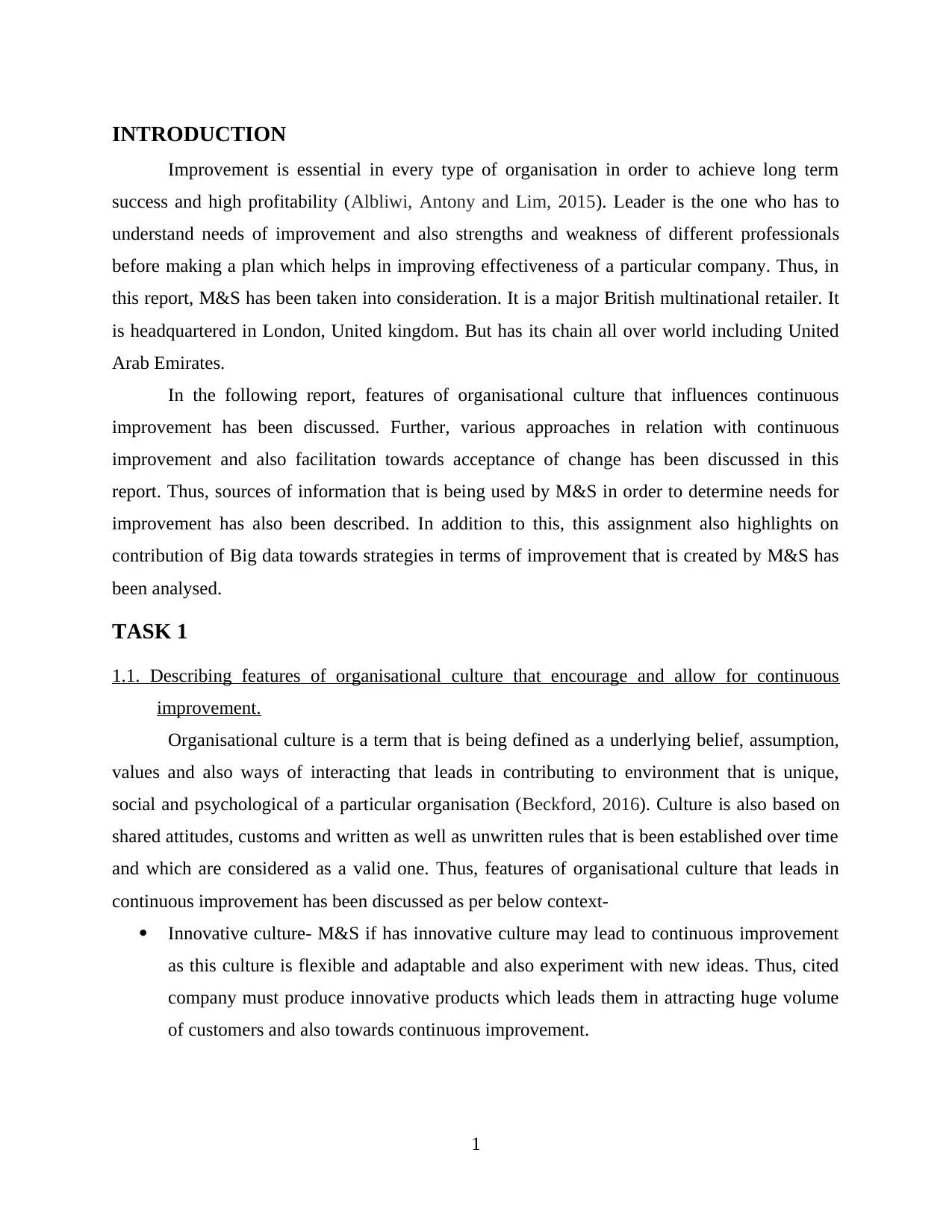
INTRODUCTION
Improvement is essential in every type of organisation in order to achieve long term
success and high profitability (Albliwi, Antony and Lim, 2015). Leader is the one who has to
understand needs of improvement and also strengths and weakness of different professionals
before making a plan which helps in improving effectiveness of a particular company. Thus, in
this report, M&S has been taken into consideration. It is a major British multinational retailer. It
is headquartered in London, United kingdom. But has its chain all over world including United
Arab Emirates.
In the following report, features of organisational culture that influences continuous
improvement has been discussed. Further, various approaches in relation with continuous
improvement and also facilitation towards acceptance of change has been discussed in this
report. Thus, sources of information that is being used by M&S in order to determine needs for
improvement has also been described. In addition to this, this assignment also highlights on
contribution of Big data towards strategies in terms of improvement that is created by M&S has
been analysed.
TASK 1
1.1. Describing features of organisational culture that encourage and allow for continuous
improvement.
Organisational culture is a term that is being defined as a underlying belief, assumption,
values and also ways of interacting that leads in contributing to environment that is unique,
social and psychological of a particular organisation (Beckford, 2016). Culture is also based on
shared attitudes, customs and written as well as unwritten rules that is been established over time
and which are considered as a valid one. Thus, features of organisational culture that leads in
continuous improvement has been discussed as per below context-
Innovative culture- M&S if has innovative culture may lead to continuous improvement
as this culture is flexible and adaptable and also experiment with new ideas. Thus, cited
company must produce innovative products which leads them in attracting huge volume
of customers and also towards continuous improvement.
1
Improvement is essential in every type of organisation in order to achieve long term
success and high profitability (Albliwi, Antony and Lim, 2015). Leader is the one who has to
understand needs of improvement and also strengths and weakness of different professionals
before making a plan which helps in improving effectiveness of a particular company. Thus, in
this report, M&S has been taken into consideration. It is a major British multinational retailer. It
is headquartered in London, United kingdom. But has its chain all over world including United
Arab Emirates.
In the following report, features of organisational culture that influences continuous
improvement has been discussed. Further, various approaches in relation with continuous
improvement and also facilitation towards acceptance of change has been discussed in this
report. Thus, sources of information that is being used by M&S in order to determine needs for
improvement has also been described. In addition to this, this assignment also highlights on
contribution of Big data towards strategies in terms of improvement that is created by M&S has
been analysed.
TASK 1
1.1. Describing features of organisational culture that encourage and allow for continuous
improvement.
Organisational culture is a term that is being defined as a underlying belief, assumption,
values and also ways of interacting that leads in contributing to environment that is unique,
social and psychological of a particular organisation (Beckford, 2016). Culture is also based on
shared attitudes, customs and written as well as unwritten rules that is been established over time
and which are considered as a valid one. Thus, features of organisational culture that leads in
continuous improvement has been discussed as per below context-
Innovative culture- M&S if has innovative culture may lead to continuous improvement
as this culture is flexible and adaptable and also experiment with new ideas. Thus, cited
company must produce innovative products which leads them in attracting huge volume
of customers and also towards continuous improvement.
1
Paraphrase This Document
Need a fresh take? Get an instant paraphrase of this document with our AI Paraphraser
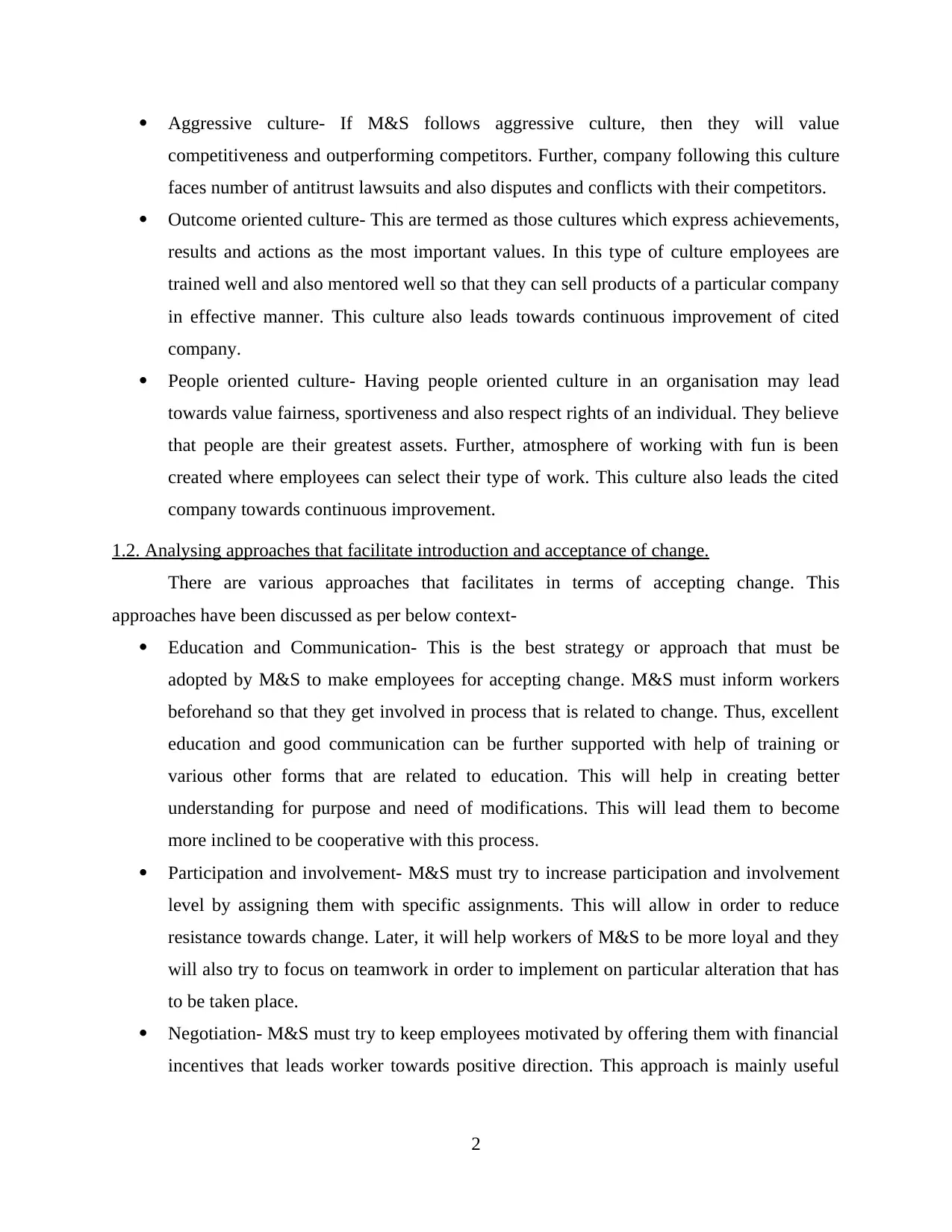
Aggressive culture- If M&S follows aggressive culture, then they will value
competitiveness and outperforming competitors. Further, company following this culture
faces number of antitrust lawsuits and also disputes and conflicts with their competitors.
Outcome oriented culture- This are termed as those cultures which express achievements,
results and actions as the most important values. In this type of culture employees are
trained well and also mentored well so that they can sell products of a particular company
in effective manner. This culture also leads towards continuous improvement of cited
company.
People oriented culture- Having people oriented culture in an organisation may lead
towards value fairness, sportiveness and also respect rights of an individual. They believe
that people are their greatest assets. Further, atmosphere of working with fun is been
created where employees can select their type of work. This culture also leads the cited
company towards continuous improvement.
1.2. Analysing approaches that facilitate introduction and acceptance of change.
There are various approaches that facilitates in terms of accepting change. This
approaches have been discussed as per below context-
Education and Communication- This is the best strategy or approach that must be
adopted by M&S to make employees for accepting change. M&S must inform workers
beforehand so that they get involved in process that is related to change. Thus, excellent
education and good communication can be further supported with help of training or
various other forms that are related to education. This will help in creating better
understanding for purpose and need of modifications. This will lead them to become
more inclined to be cooperative with this process.
Participation and involvement- M&S must try to increase participation and involvement
level by assigning them with specific assignments. This will allow in order to reduce
resistance towards change. Later, it will help workers of M&S to be more loyal and they
will also try to focus on teamwork in order to implement on particular alteration that has
to be taken place.
Negotiation- M&S must try to keep employees motivated by offering them with financial
incentives that leads worker towards positive direction. This approach is mainly useful
2
competitiveness and outperforming competitors. Further, company following this culture
faces number of antitrust lawsuits and also disputes and conflicts with their competitors.
Outcome oriented culture- This are termed as those cultures which express achievements,
results and actions as the most important values. In this type of culture employees are
trained well and also mentored well so that they can sell products of a particular company
in effective manner. This culture also leads towards continuous improvement of cited
company.
People oriented culture- Having people oriented culture in an organisation may lead
towards value fairness, sportiveness and also respect rights of an individual. They believe
that people are their greatest assets. Further, atmosphere of working with fun is been
created where employees can select their type of work. This culture also leads the cited
company towards continuous improvement.
1.2. Analysing approaches that facilitate introduction and acceptance of change.
There are various approaches that facilitates in terms of accepting change. This
approaches have been discussed as per below context-
Education and Communication- This is the best strategy or approach that must be
adopted by M&S to make employees for accepting change. M&S must inform workers
beforehand so that they get involved in process that is related to change. Thus, excellent
education and good communication can be further supported with help of training or
various other forms that are related to education. This will help in creating better
understanding for purpose and need of modifications. This will lead them to become
more inclined to be cooperative with this process.
Participation and involvement- M&S must try to increase participation and involvement
level by assigning them with specific assignments. This will allow in order to reduce
resistance towards change. Later, it will help workers of M&S to be more loyal and they
will also try to focus on teamwork in order to implement on particular alteration that has
to be taken place.
Negotiation- M&S must try to keep employees motivated by offering them with financial
incentives that leads worker towards positive direction. This approach is mainly useful
2
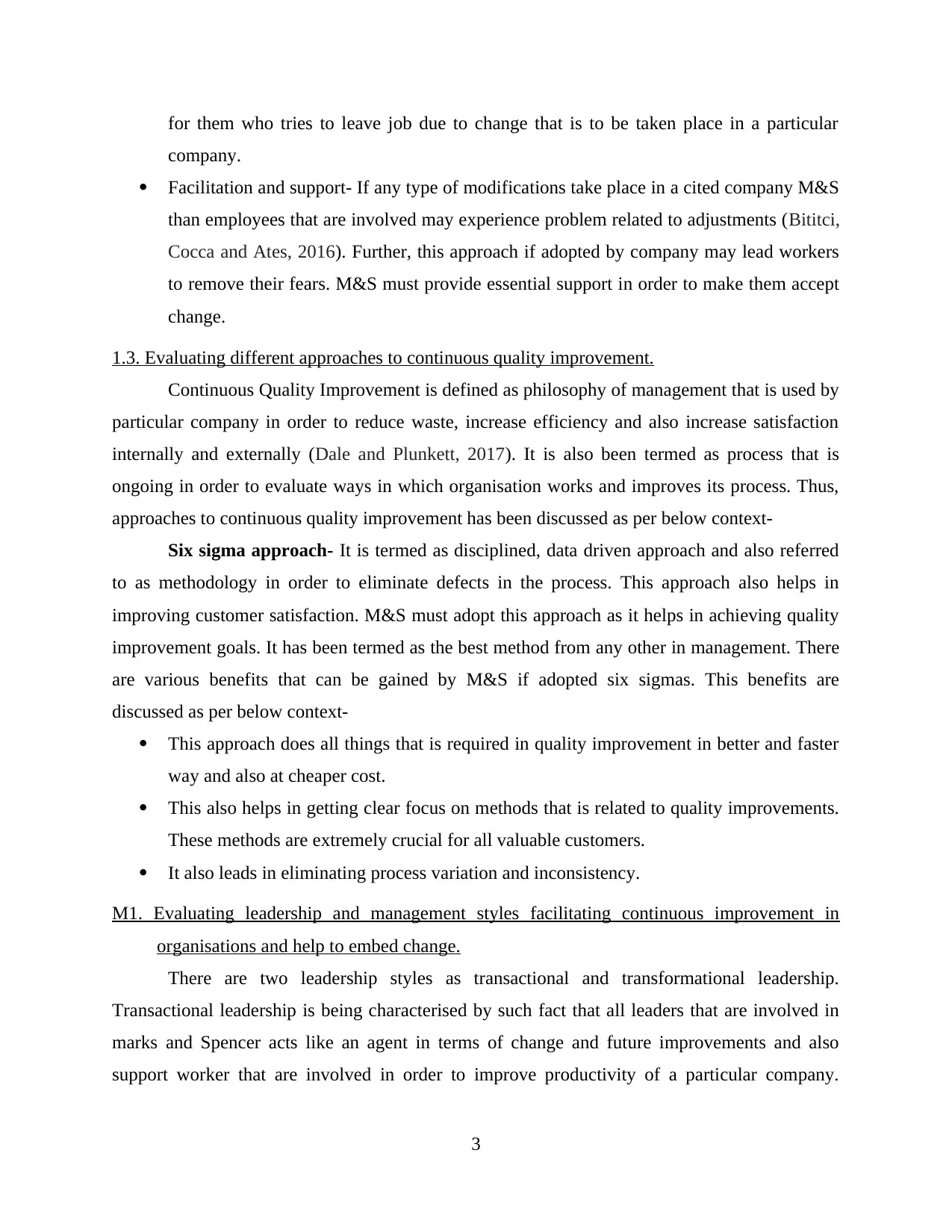
for them who tries to leave job due to change that is to be taken place in a particular
company.
Facilitation and support- If any type of modifications take place in a cited company M&S
than employees that are involved may experience problem related to adjustments (Bititci,
Cocca and Ates, 2016). Further, this approach if adopted by company may lead workers
to remove their fears. M&S must provide essential support in order to make them accept
change.
1.3. Evaluating different approaches to continuous quality improvement.
Continuous Quality Improvement is defined as philosophy of management that is used by
particular company in order to reduce waste, increase efficiency and also increase satisfaction
internally and externally (Dale and Plunkett, 2017). It is also been termed as process that is
ongoing in order to evaluate ways in which organisation works and improves its process. Thus,
approaches to continuous quality improvement has been discussed as per below context-
Six sigma approach- It is termed as disciplined, data driven approach and also referred
to as methodology in order to eliminate defects in the process. This approach also helps in
improving customer satisfaction. M&S must adopt this approach as it helps in achieving quality
improvement goals. It has been termed as the best method from any other in management. There
are various benefits that can be gained by M&S if adopted six sigmas. This benefits are
discussed as per below context-
This approach does all things that is required in quality improvement in better and faster
way and also at cheaper cost.
This also helps in getting clear focus on methods that is related to quality improvements.
These methods are extremely crucial for all valuable customers.
It also leads in eliminating process variation and inconsistency.
M1. Evaluating leadership and management styles facilitating continuous improvement in
organisations and help to embed change.
There are two leadership styles as transactional and transformational leadership.
Transactional leadership is being characterised by such fact that all leaders that are involved in
marks and Spencer acts like an agent in terms of change and future improvements and also
support worker that are involved in order to improve productivity of a particular company.
3
company.
Facilitation and support- If any type of modifications take place in a cited company M&S
than employees that are involved may experience problem related to adjustments (Bititci,
Cocca and Ates, 2016). Further, this approach if adopted by company may lead workers
to remove their fears. M&S must provide essential support in order to make them accept
change.
1.3. Evaluating different approaches to continuous quality improvement.
Continuous Quality Improvement is defined as philosophy of management that is used by
particular company in order to reduce waste, increase efficiency and also increase satisfaction
internally and externally (Dale and Plunkett, 2017). It is also been termed as process that is
ongoing in order to evaluate ways in which organisation works and improves its process. Thus,
approaches to continuous quality improvement has been discussed as per below context-
Six sigma approach- It is termed as disciplined, data driven approach and also referred
to as methodology in order to eliminate defects in the process. This approach also helps in
improving customer satisfaction. M&S must adopt this approach as it helps in achieving quality
improvement goals. It has been termed as the best method from any other in management. There
are various benefits that can be gained by M&S if adopted six sigmas. This benefits are
discussed as per below context-
This approach does all things that is required in quality improvement in better and faster
way and also at cheaper cost.
This also helps in getting clear focus on methods that is related to quality improvements.
These methods are extremely crucial for all valuable customers.
It also leads in eliminating process variation and inconsistency.
M1. Evaluating leadership and management styles facilitating continuous improvement in
organisations and help to embed change.
There are two leadership styles as transactional and transformational leadership.
Transactional leadership is being characterised by such fact that all leaders that are involved in
marks and Spencer acts like an agent in terms of change and future improvements and also
support worker that are involved in order to improve productivity of a particular company.
3
⊘ This is a preview!⊘
Do you want full access?
Subscribe today to unlock all pages.

Trusted by 1+ million students worldwide

Transformational leadership style implies that leader tries to make employees of M&S in order to
imagine vision of organisations that reflects towards increase in productivity.
D1. Assessing importance of continuous improvement in supporting organisational success.
Continuous improvement plays essential role in order to achieve high profitability and
long term success of M&S. Thus, its importance has been discussed as per below context-
Employees are more engaged. As continuous improvement is being developed in order to
empower employees of M&S so that they can solve problems (Sabet, Adams and
Yazdani, 2016). This also leads in increasing efficiency in their process related to work.
There is also lack of employee turnover. Thus, continuous improvement culture has
shown boost to engagement of employees and also leads in reducing turnover rates. This
continuous improvement leads towards increased sense of belonging and fewer reasons in
order to leave organisation.
TASK 2
2.1. Analysing sources of information used by organisations to help identify improvements that
are needed.
Improvement in M&S plays essential and critical role. Therefore, primary goals that has
been identified in terms of improvement includes increase in effectiveness and efficiency of
organisation (Evans and Lindsay, 2014). This will help them in improving ability of particular
organisation M&S so that they can deliver goods and services in appropriate manner. Thus,
sources through which information can be collected for requirement of improvement has been
discussed as per below context-
Meetings- This is one of the most important source from which information can be
gathered in order to analyse requirement of improvement in M&S. Therefore, they must
finalise meetings with key and controlling stakeholders. This will lead them in
determining expectations and also the timeline and accordingly make improvements.
Interviews- Interviews must be conducted with staffs as it will help in to find answers for
specific questions. This will also help in identifying strengths, weakness, opportunities
and threats that is involved in M&S and accordingly making and implementation of plans
is being done for future improvements.
4
imagine vision of organisations that reflects towards increase in productivity.
D1. Assessing importance of continuous improvement in supporting organisational success.
Continuous improvement plays essential role in order to achieve high profitability and
long term success of M&S. Thus, its importance has been discussed as per below context-
Employees are more engaged. As continuous improvement is being developed in order to
empower employees of M&S so that they can solve problems (Sabet, Adams and
Yazdani, 2016). This also leads in increasing efficiency in their process related to work.
There is also lack of employee turnover. Thus, continuous improvement culture has
shown boost to engagement of employees and also leads in reducing turnover rates. This
continuous improvement leads towards increased sense of belonging and fewer reasons in
order to leave organisation.
TASK 2
2.1. Analysing sources of information used by organisations to help identify improvements that
are needed.
Improvement in M&S plays essential and critical role. Therefore, primary goals that has
been identified in terms of improvement includes increase in effectiveness and efficiency of
organisation (Evans and Lindsay, 2014). This will help them in improving ability of particular
organisation M&S so that they can deliver goods and services in appropriate manner. Thus,
sources through which information can be collected for requirement of improvement has been
discussed as per below context-
Meetings- This is one of the most important source from which information can be
gathered in order to analyse requirement of improvement in M&S. Therefore, they must
finalise meetings with key and controlling stakeholders. This will lead them in
determining expectations and also the timeline and accordingly make improvements.
Interviews- Interviews must be conducted with staffs as it will help in to find answers for
specific questions. This will also help in identifying strengths, weakness, opportunities
and threats that is involved in M&S and accordingly making and implementation of plans
is being done for future improvements.
4
Paraphrase This Document
Need a fresh take? Get an instant paraphrase of this document with our AI Paraphraser
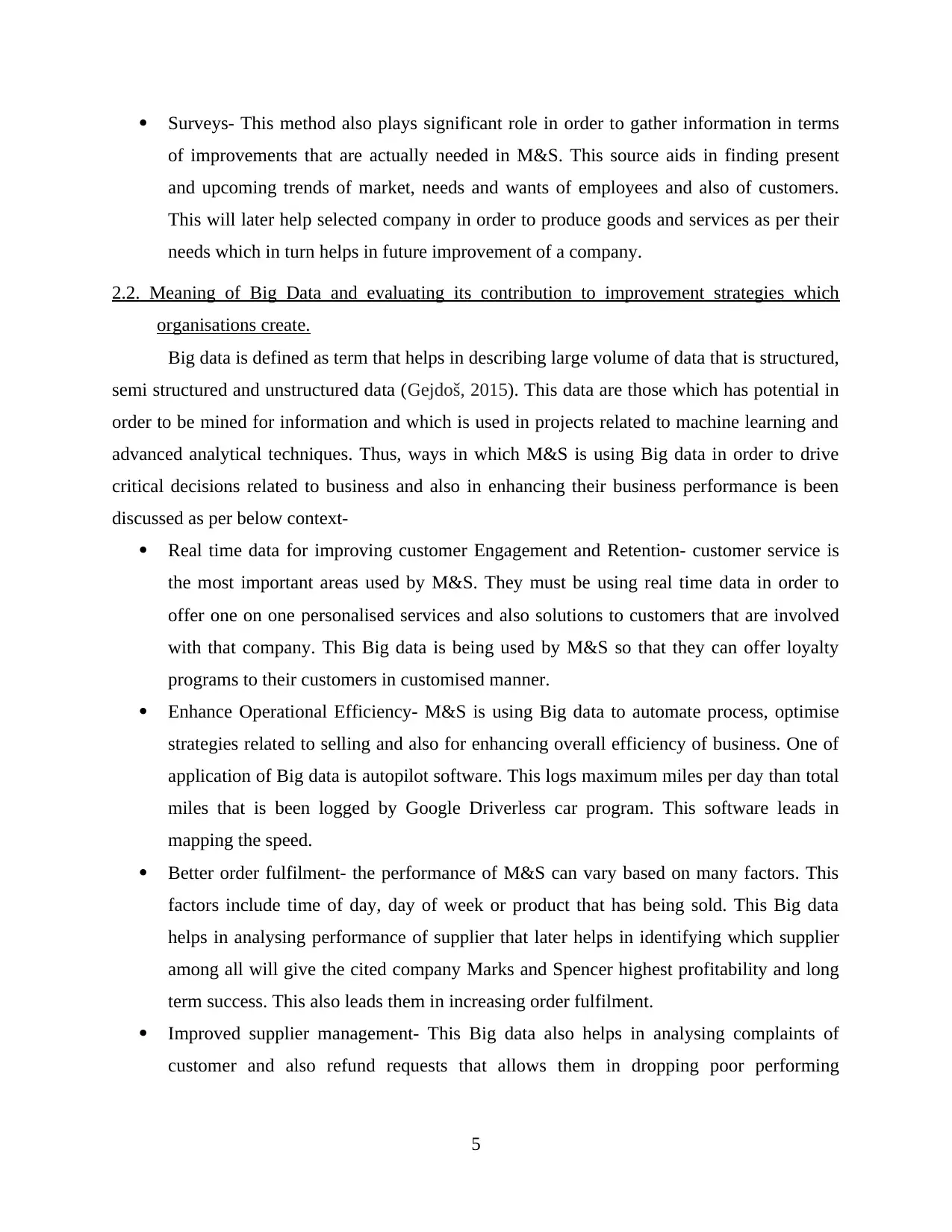
Surveys- This method also plays significant role in order to gather information in terms
of improvements that are actually needed in M&S. This source aids in finding present
and upcoming trends of market, needs and wants of employees and also of customers.
This will later help selected company in order to produce goods and services as per their
needs which in turn helps in future improvement of a company.
2.2. Meaning of Big Data and evaluating its contribution to improvement strategies which
organisations create.
Big data is defined as term that helps in describing large volume of data that is structured,
semi structured and unstructured data (Gejdoš, 2015). This data are those which has potential in
order to be mined for information and which is used in projects related to machine learning and
advanced analytical techniques. Thus, ways in which M&S is using Big data in order to drive
critical decisions related to business and also in enhancing their business performance is been
discussed as per below context-
Real time data for improving customer Engagement and Retention- customer service is
the most important areas used by M&S. They must be using real time data in order to
offer one on one personalised services and also solutions to customers that are involved
with that company. This Big data is being used by M&S so that they can offer loyalty
programs to their customers in customised manner.
Enhance Operational Efficiency- M&S is using Big data to automate process, optimise
strategies related to selling and also for enhancing overall efficiency of business. One of
application of Big data is autopilot software. This logs maximum miles per day than total
miles that is been logged by Google Driverless car program. This software leads in
mapping the speed.
Better order fulfilment- the performance of M&S can vary based on many factors. This
factors include time of day, day of week or product that has being sold. This Big data
helps in analysing performance of supplier that later helps in identifying which supplier
among all will give the cited company Marks and Spencer highest profitability and long
term success. This also leads them in increasing order fulfilment.
Improved supplier management- This Big data also helps in analysing complaints of
customer and also refund requests that allows them in dropping poor performing
5
of improvements that are actually needed in M&S. This source aids in finding present
and upcoming trends of market, needs and wants of employees and also of customers.
This will later help selected company in order to produce goods and services as per their
needs which in turn helps in future improvement of a company.
2.2. Meaning of Big Data and evaluating its contribution to improvement strategies which
organisations create.
Big data is defined as term that helps in describing large volume of data that is structured,
semi structured and unstructured data (Gejdoš, 2015). This data are those which has potential in
order to be mined for information and which is used in projects related to machine learning and
advanced analytical techniques. Thus, ways in which M&S is using Big data in order to drive
critical decisions related to business and also in enhancing their business performance is been
discussed as per below context-
Real time data for improving customer Engagement and Retention- customer service is
the most important areas used by M&S. They must be using real time data in order to
offer one on one personalised services and also solutions to customers that are involved
with that company. This Big data is being used by M&S so that they can offer loyalty
programs to their customers in customised manner.
Enhance Operational Efficiency- M&S is using Big data to automate process, optimise
strategies related to selling and also for enhancing overall efficiency of business. One of
application of Big data is autopilot software. This logs maximum miles per day than total
miles that is been logged by Google Driverless car program. This software leads in
mapping the speed.
Better order fulfilment- the performance of M&S can vary based on many factors. This
factors include time of day, day of week or product that has being sold. This Big data
helps in analysing performance of supplier that later helps in identifying which supplier
among all will give the cited company Marks and Spencer highest profitability and long
term success. This also leads them in increasing order fulfilment.
Improved supplier management- This Big data also helps in analysing complaints of
customer and also refund requests that allows them in dropping poor performing
5
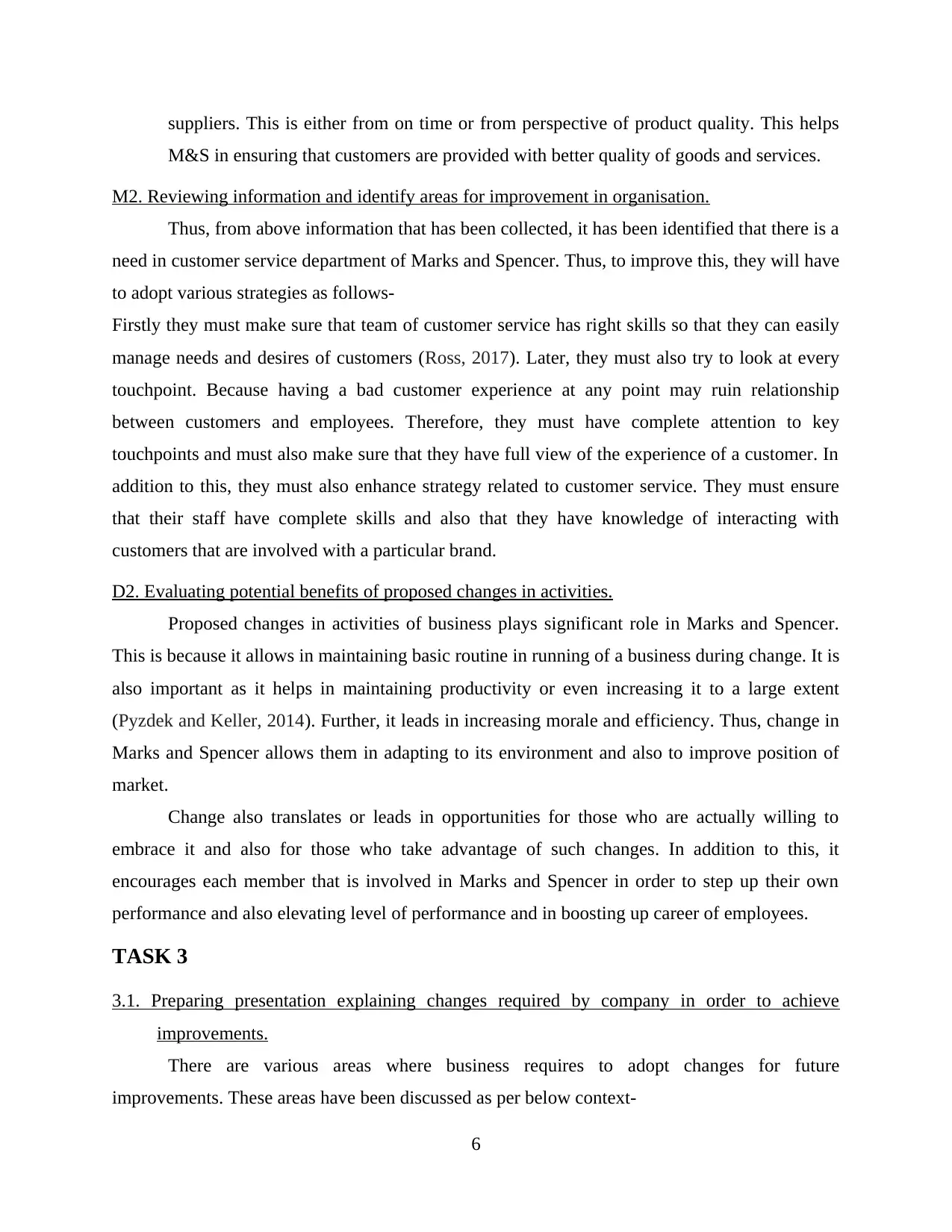
suppliers. This is either from on time or from perspective of product quality. This helps
M&S in ensuring that customers are provided with better quality of goods and services.
M2. Reviewing information and identify areas for improvement in organisation.
Thus, from above information that has been collected, it has been identified that there is a
need in customer service department of Marks and Spencer. Thus, to improve this, they will have
to adopt various strategies as follows-
Firstly they must make sure that team of customer service has right skills so that they can easily
manage needs and desires of customers (Ross, 2017). Later, they must also try to look at every
touchpoint. Because having a bad customer experience at any point may ruin relationship
between customers and employees. Therefore, they must have complete attention to key
touchpoints and must also make sure that they have full view of the experience of a customer. In
addition to this, they must also enhance strategy related to customer service. They must ensure
that their staff have complete skills and also that they have knowledge of interacting with
customers that are involved with a particular brand.
D2. Evaluating potential benefits of proposed changes in activities.
Proposed changes in activities of business plays significant role in Marks and Spencer.
This is because it allows in maintaining basic routine in running of a business during change. It is
also important as it helps in maintaining productivity or even increasing it to a large extent
(Pyzdek and Keller, 2014). Further, it leads in increasing morale and efficiency. Thus, change in
Marks and Spencer allows them in adapting to its environment and also to improve position of
market.
Change also translates or leads in opportunities for those who are actually willing to
embrace it and also for those who take advantage of such changes. In addition to this, it
encourages each member that is involved in Marks and Spencer in order to step up their own
performance and also elevating level of performance and in boosting up career of employees.
TASK 3
3.1. Preparing presentation explaining changes required by company in order to achieve
improvements.
There are various areas where business requires to adopt changes for future
improvements. These areas have been discussed as per below context-
6
M&S in ensuring that customers are provided with better quality of goods and services.
M2. Reviewing information and identify areas for improvement in organisation.
Thus, from above information that has been collected, it has been identified that there is a
need in customer service department of Marks and Spencer. Thus, to improve this, they will have
to adopt various strategies as follows-
Firstly they must make sure that team of customer service has right skills so that they can easily
manage needs and desires of customers (Ross, 2017). Later, they must also try to look at every
touchpoint. Because having a bad customer experience at any point may ruin relationship
between customers and employees. Therefore, they must have complete attention to key
touchpoints and must also make sure that they have full view of the experience of a customer. In
addition to this, they must also enhance strategy related to customer service. They must ensure
that their staff have complete skills and also that they have knowledge of interacting with
customers that are involved with a particular brand.
D2. Evaluating potential benefits of proposed changes in activities.
Proposed changes in activities of business plays significant role in Marks and Spencer.
This is because it allows in maintaining basic routine in running of a business during change. It is
also important as it helps in maintaining productivity or even increasing it to a large extent
(Pyzdek and Keller, 2014). Further, it leads in increasing morale and efficiency. Thus, change in
Marks and Spencer allows them in adapting to its environment and also to improve position of
market.
Change also translates or leads in opportunities for those who are actually willing to
embrace it and also for those who take advantage of such changes. In addition to this, it
encourages each member that is involved in Marks and Spencer in order to step up their own
performance and also elevating level of performance and in boosting up career of employees.
TASK 3
3.1. Preparing presentation explaining changes required by company in order to achieve
improvements.
There are various areas where business requires to adopt changes for future
improvements. These areas have been discussed as per below context-
6
⊘ This is a preview!⊘
Do you want full access?
Subscribe today to unlock all pages.

Trusted by 1+ million students worldwide
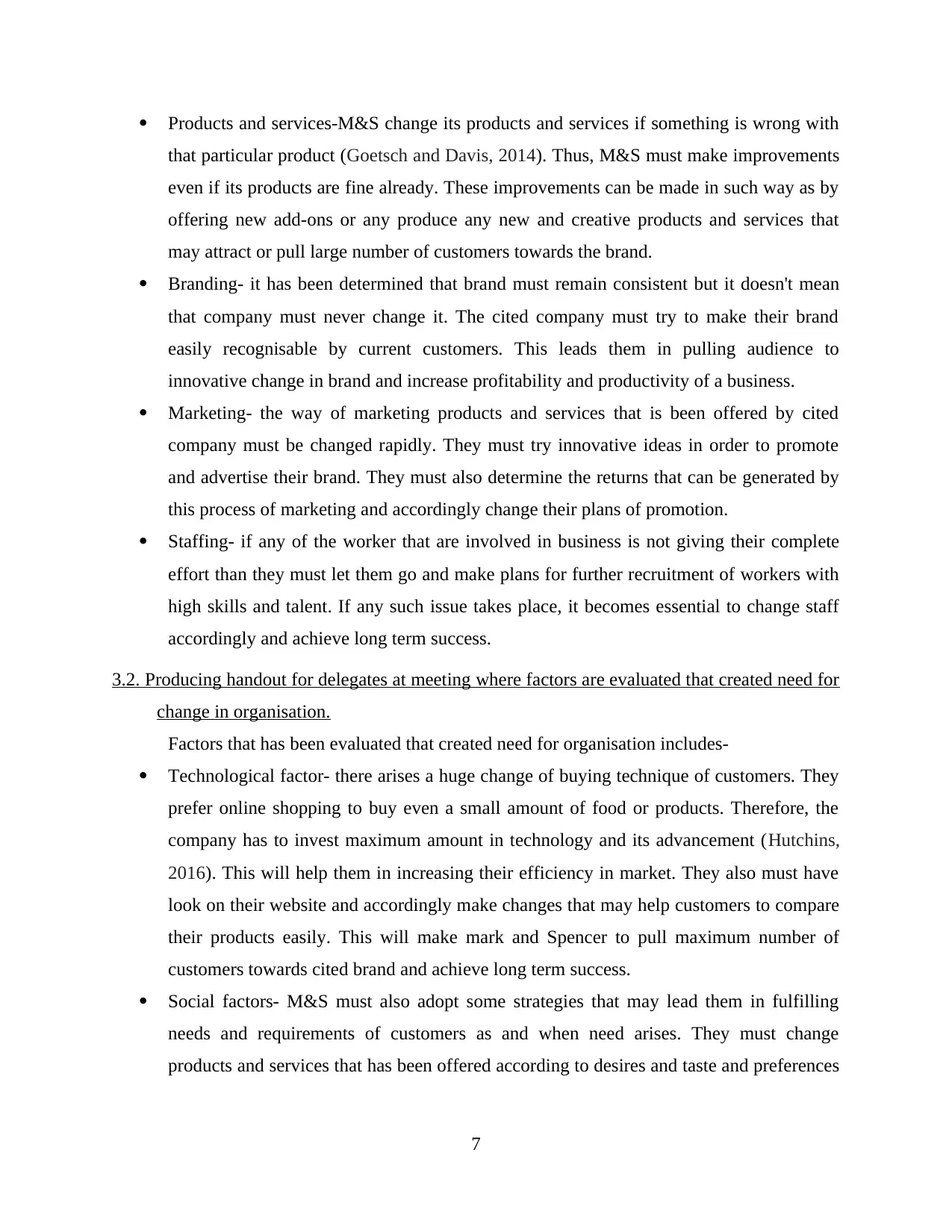
Products and services-M&S change its products and services if something is wrong with
that particular product (Goetsch and Davis, 2014). Thus, M&S must make improvements
even if its products are fine already. These improvements can be made in such way as by
offering new add-ons or any produce any new and creative products and services that
may attract or pull large number of customers towards the brand.
Branding- it has been determined that brand must remain consistent but it doesn't mean
that company must never change it. The cited company must try to make their brand
easily recognisable by current customers. This leads them in pulling audience to
innovative change in brand and increase profitability and productivity of a business.
Marketing- the way of marketing products and services that is been offered by cited
company must be changed rapidly. They must try innovative ideas in order to promote
and advertise their brand. They must also determine the returns that can be generated by
this process of marketing and accordingly change their plans of promotion.
Staffing- if any of the worker that are involved in business is not giving their complete
effort than they must let them go and make plans for further recruitment of workers with
high skills and talent. If any such issue takes place, it becomes essential to change staff
accordingly and achieve long term success.
3.2. Producing handout for delegates at meeting where factors are evaluated that created need for
change in organisation.
Factors that has been evaluated that created need for organisation includes-
Technological factor- there arises a huge change of buying technique of customers. They
prefer online shopping to buy even a small amount of food or products. Therefore, the
company has to invest maximum amount in technology and its advancement (Hutchins,
2016). This will help them in increasing their efficiency in market. They also must have
look on their website and accordingly make changes that may help customers to compare
their products easily. This will make mark and Spencer to pull maximum number of
customers towards cited brand and achieve long term success.
Social factors- M&S must also adopt some strategies that may lead them in fulfilling
needs and requirements of customers as and when need arises. They must change
products and services that has been offered according to desires and taste and preferences
7
that particular product (Goetsch and Davis, 2014). Thus, M&S must make improvements
even if its products are fine already. These improvements can be made in such way as by
offering new add-ons or any produce any new and creative products and services that
may attract or pull large number of customers towards the brand.
Branding- it has been determined that brand must remain consistent but it doesn't mean
that company must never change it. The cited company must try to make their brand
easily recognisable by current customers. This leads them in pulling audience to
innovative change in brand and increase profitability and productivity of a business.
Marketing- the way of marketing products and services that is been offered by cited
company must be changed rapidly. They must try innovative ideas in order to promote
and advertise their brand. They must also determine the returns that can be generated by
this process of marketing and accordingly change their plans of promotion.
Staffing- if any of the worker that are involved in business is not giving their complete
effort than they must let them go and make plans for further recruitment of workers with
high skills and talent. If any such issue takes place, it becomes essential to change staff
accordingly and achieve long term success.
3.2. Producing handout for delegates at meeting where factors are evaluated that created need for
change in organisation.
Factors that has been evaluated that created need for organisation includes-
Technological factor- there arises a huge change of buying technique of customers. They
prefer online shopping to buy even a small amount of food or products. Therefore, the
company has to invest maximum amount in technology and its advancement (Hutchins,
2016). This will help them in increasing their efficiency in market. They also must have
look on their website and accordingly make changes that may help customers to compare
their products easily. This will make mark and Spencer to pull maximum number of
customers towards cited brand and achieve long term success.
Social factors- M&S must also adopt some strategies that may lead them in fulfilling
needs and requirements of customers as and when need arises. They must change
products and services that has been offered according to desires and taste and preferences
7
Paraphrase This Document
Need a fresh take? Get an instant paraphrase of this document with our AI Paraphraser
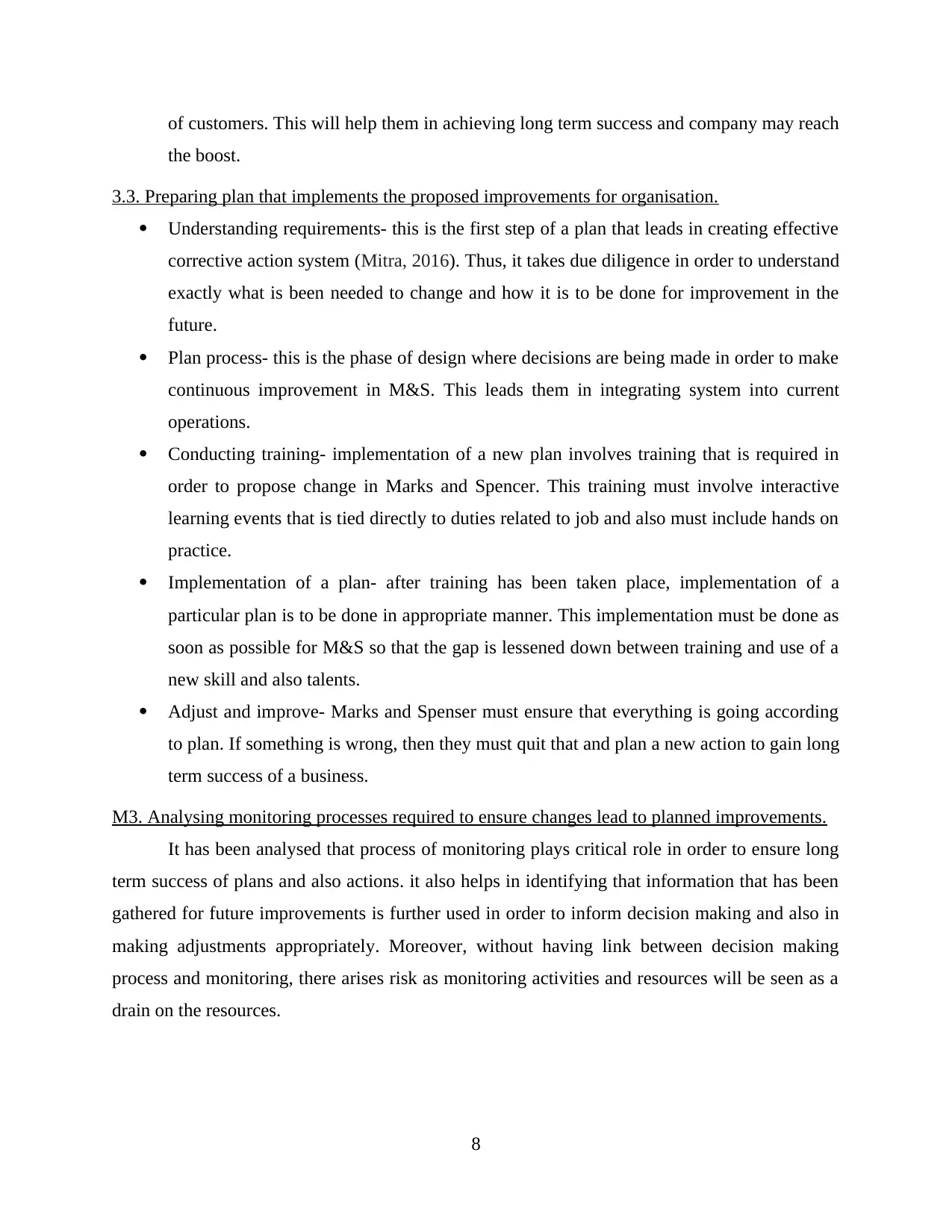
of customers. This will help them in achieving long term success and company may reach
the boost.
3.3. Preparing plan that implements the proposed improvements for organisation.
Understanding requirements- this is the first step of a plan that leads in creating effective
corrective action system (Mitra, 2016). Thus, it takes due diligence in order to understand
exactly what is been needed to change and how it is to be done for improvement in the
future.
Plan process- this is the phase of design where decisions are being made in order to make
continuous improvement in M&S. This leads them in integrating system into current
operations.
Conducting training- implementation of a new plan involves training that is required in
order to propose change in Marks and Spencer. This training must involve interactive
learning events that is tied directly to duties related to job and also must include hands on
practice.
Implementation of a plan- after training has been taken place, implementation of a
particular plan is to be done in appropriate manner. This implementation must be done as
soon as possible for M&S so that the gap is lessened down between training and use of a
new skill and also talents.
Adjust and improve- Marks and Spenser must ensure that everything is going according
to plan. If something is wrong, then they must quit that and plan a new action to gain long
term success of a business.
M3. Analysing monitoring processes required to ensure changes lead to planned improvements.
It has been analysed that process of monitoring plays critical role in order to ensure long
term success of plans and also actions. it also helps in identifying that information that has been
gathered for future improvements is further used in order to inform decision making and also in
making adjustments appropriately. Moreover, without having link between decision making
process and monitoring, there arises risk as monitoring activities and resources will be seen as a
drain on the resources.
8
the boost.
3.3. Preparing plan that implements the proposed improvements for organisation.
Understanding requirements- this is the first step of a plan that leads in creating effective
corrective action system (Mitra, 2016). Thus, it takes due diligence in order to understand
exactly what is been needed to change and how it is to be done for improvement in the
future.
Plan process- this is the phase of design where decisions are being made in order to make
continuous improvement in M&S. This leads them in integrating system into current
operations.
Conducting training- implementation of a new plan involves training that is required in
order to propose change in Marks and Spencer. This training must involve interactive
learning events that is tied directly to duties related to job and also must include hands on
practice.
Implementation of a plan- after training has been taken place, implementation of a
particular plan is to be done in appropriate manner. This implementation must be done as
soon as possible for M&S so that the gap is lessened down between training and use of a
new skill and also talents.
Adjust and improve- Marks and Spenser must ensure that everything is going according
to plan. If something is wrong, then they must quit that and plan a new action to gain long
term success of a business.
M3. Analysing monitoring processes required to ensure changes lead to planned improvements.
It has been analysed that process of monitoring plays critical role in order to ensure long
term success of plans and also actions. it also helps in identifying that information that has been
gathered for future improvements is further used in order to inform decision making and also in
making adjustments appropriately. Moreover, without having link between decision making
process and monitoring, there arises risk as monitoring activities and resources will be seen as a
drain on the resources.
8
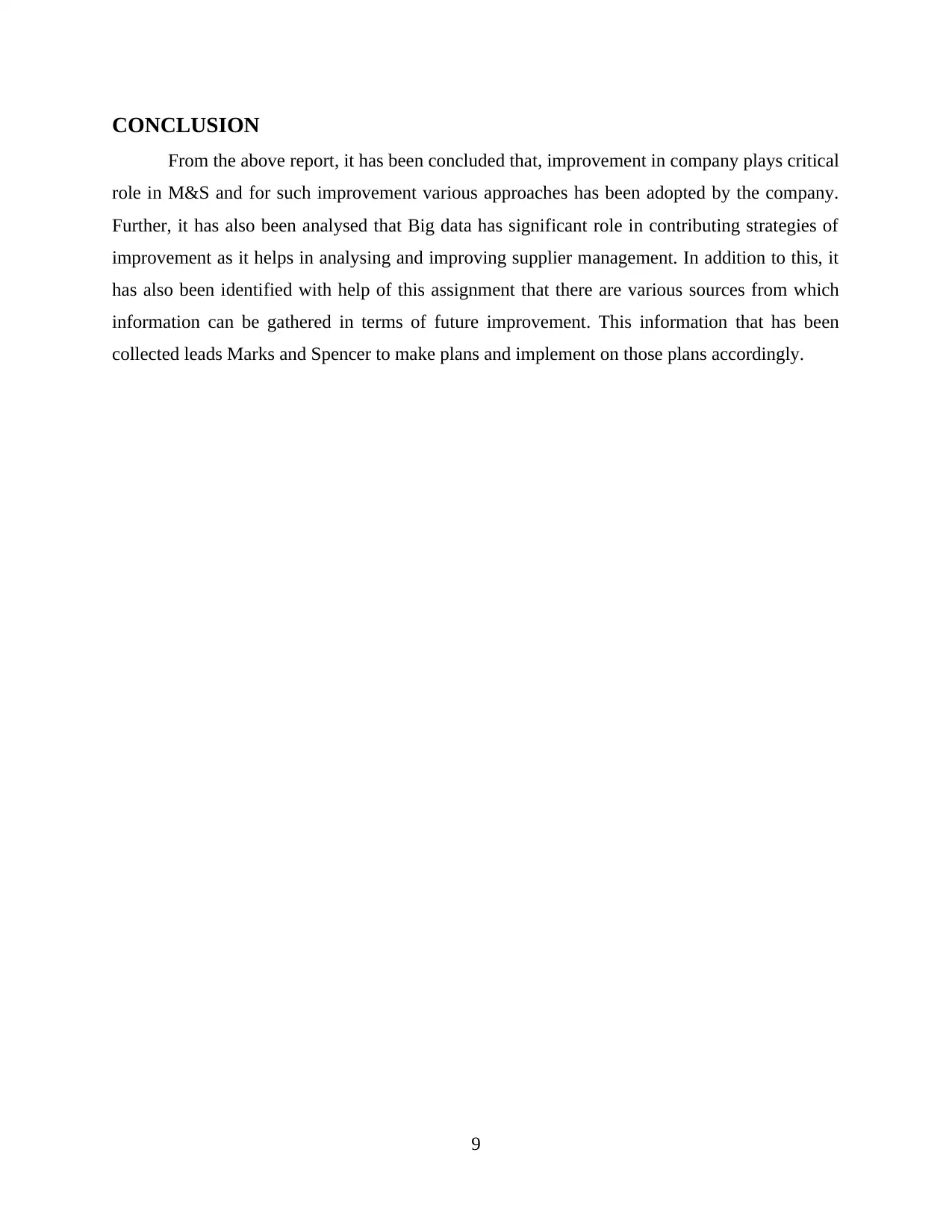
CONCLUSION
From the above report, it has been concluded that, improvement in company plays critical
role in M&S and for such improvement various approaches has been adopted by the company.
Further, it has also been analysed that Big data has significant role in contributing strategies of
improvement as it helps in analysing and improving supplier management. In addition to this, it
has also been identified with help of this assignment that there are various sources from which
information can be gathered in terms of future improvement. This information that has been
collected leads Marks and Spencer to make plans and implement on those plans accordingly.
9
From the above report, it has been concluded that, improvement in company plays critical
role in M&S and for such improvement various approaches has been adopted by the company.
Further, it has also been analysed that Big data has significant role in contributing strategies of
improvement as it helps in analysing and improving supplier management. In addition to this, it
has also been identified with help of this assignment that there are various sources from which
information can be gathered in terms of future improvement. This information that has been
collected leads Marks and Spencer to make plans and implement on those plans accordingly.
9
⊘ This is a preview!⊘
Do you want full access?
Subscribe today to unlock all pages.

Trusted by 1+ million students worldwide
1 out of 13
Related Documents
Your All-in-One AI-Powered Toolkit for Academic Success.
+13062052269
info@desklib.com
Available 24*7 on WhatsApp / Email
![[object Object]](/_next/static/media/star-bottom.7253800d.svg)
Unlock your academic potential
Copyright © 2020–2025 A2Z Services. All Rights Reserved. Developed and managed by ZUCOL.





